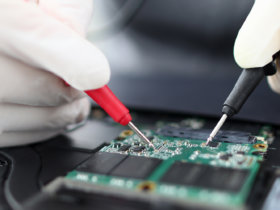Spatial electronics pushing back production limits
Hear how this can transform the world of products, and put your questions to the expert. Register for Let’s Talk Science, the monthly online seminar for EMO Hannover 2023, at 8:30 am on 26 October 2022

New generations of 3D printers could see the arrival of entirely new types of products on the market in five to ten years. What is innovative about these printers is that they can simultaneously print electronic functions such as light-emitting diodes and conductor paths. “3D electronics is giving rise to a whole new range of possibilities because it is opening up entirely new degrees of spatial freedom. In the future, we will simply be able to print individual hearing aids, prostheses or even smartwatches,” explains Markus Ankenbrand of the FAPS institute at the University of Erlangen-Nuremberg, and Let’s Talk Science presenter. The electronic components are adapted to the shape of the product – and not vice versa.
Electronic devices in particular are subject to contradictory pressures: costs need to be kept low, yet more and more functions are being integrated and the devices are becoming ever smaller. A key driver of this development is the rapidly evolving Internet of Things, which is resulting in more and more smart devices with ever new functions. This, in turn, is accelerating the need for new manufacturing technologies. Here, spatial electronics can offer completely new possibilities for integrating mechanical, electrical/electronic, thermal or even optical functions. In the future, 3D printers will be able to create innovative devices with sensors, actuators, displays or even antennas.
The October issue of Let’s Talk Science will feature the manufacturing technologies and applications of the existing “mechatronic integrated assemblies” (MIDs) and the possibilities for new product functions based on them. Finally, Markus Ankenbrand takes a look into the future and reveals how far researchers are along the road to the fully additive manufacturing of electronic products.
Hear how this can transform the world of products, and put your questions to the expert. Register for Let’s Talk Science, the monthly online seminar for EMO Hannover 2023, at 8:30 am on 26 October 2022.
Presenter
Markus Ankenbrand, research associate at the Institute for Factory Automation and Production Systems (FAPS), University of Erlangen-Nuremberg.
Photos
Image 1: Printed circuit boards could become a thing of the past. Source: Adobe Stoc-H_Ko-299919395
Image 2: Apple Airpod, tiny electronics – although not printed. Source: Apple
Image 3: Markus Ankenbrand, Source: FAPS Erlangen-Nuremberg
Author: Gerda Kneifel, VDW
Registration
Downloads
Dokumente
Pictures
Image 1: Printed circuit boards could become a thing of the past. Source: Adobe Stoc-H_Ko-299919395
Image 2: Apple Airpod, tiny electronics – although not printed. Source: Apple





